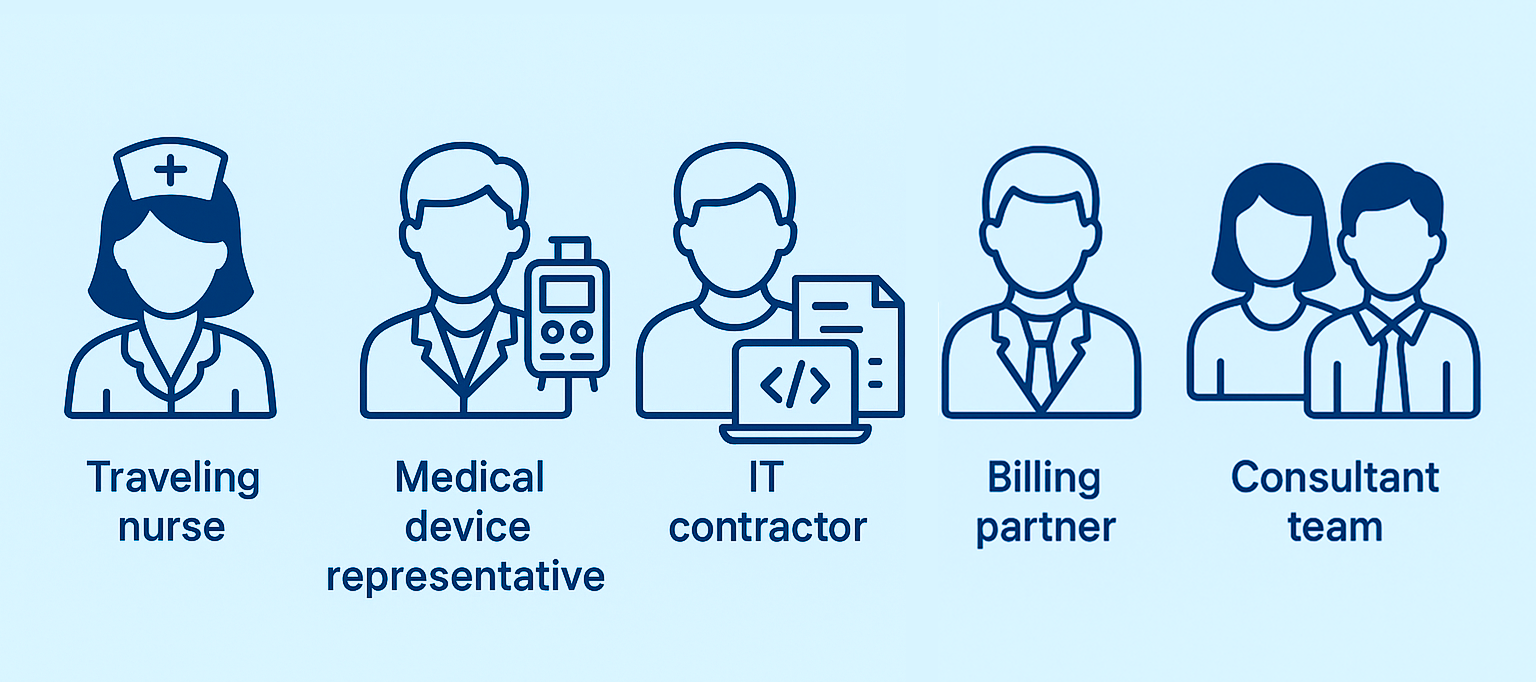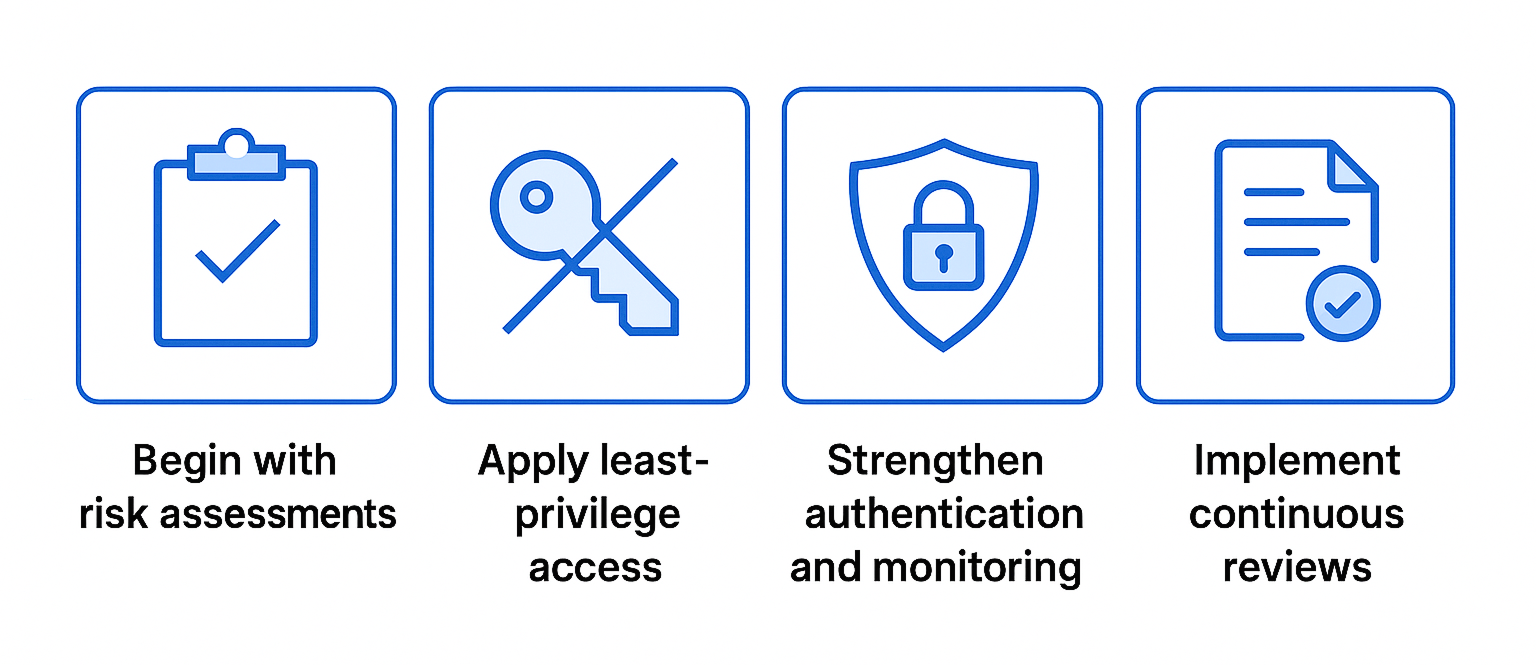Non-Employee Insider Risks in Healthcare: Reducing Third-Party Threats
Healthcare organizations are in a perpetual state of pressure to protect vast amounts of sensitive patient data. While external cyberattacks often make headlines, insider risks are becoming a leading cause of breaches—specifically those involving non-employees like contractors, vendors, and temporary staff. These identities have the same or even higher levels of access to critical systems as full-time employees but are harder to monitor.
The healthcare industry relies heavily on third-party suppliers and employees to deliver services at scale. Telehealth vendors, medical device suppliers, billing agencies, and travel nurses are just a few examples. These roles often need to access electronic health records (EHRs), clinical systems, or cloud portals, creating multiple entry points for attackers and heightening the threat of accidental exposure.
Reducing non-employee insider risk calls for more than just your typical identity and access management (IAM) procedures. It also requires a closer look at how third-party identities are established, kept current, and removed when they are no longer needed.
Non-employee insider risks in healthcare
Non-employee risks are security threats that originate from individuals who are not direct employees but have the authority to enter a healthcare organization's systems, data, or facilities. These risks do not get detected as third-party roles might be temporary or span multiple business units, making them harder to track.

Who are non-employees in healthcare?
Healthcare organizations engage with a broad range of third parties. Some examples are:
• Contractors and consulting firms contracted for brief projects.
• Traveling nurses and physicians staffing short-staffed clinics.
• External billing and claims processing companies.
• IT vendors providing infrastructure or support services.
• Medical device and equipment maintenance reps.
Why they pose special risks
Unlike full-time employees, non-employees often join and leave organizations in a short period of time. This rapid churn makes it easy for accounts to remain active after a contract has ended. Many also swap credentials with coworkers or use personal devices to access healthcare networks, reducing surveillance even more.
Some of the most critical risk factors include:
• Undefined ownership for approval and removal of access.
• Inconsistent background checks or vetting.
• Varying levels of cybersecurity awareness within vendors and contractors.
The unique vulnerabilities that healthcare faces
Healthcare organizations face security issues that leave them more susceptible to non-employee insider threats than most other industries. Such vulnerabilities are derived from government regulation and the numerous third-party relationships needed to offer care.
High vendor dependence
Hospitals and health systems rely more and more on outside partners for important functions. Telehealth platforms, cloud hosting providers, revenue cycle management providers, and clinical labs are just a few examples. If these identities aren't adequately managed, it's difficult to ascertain whether each partner is following the required security practices.
Fragmented access environments
Most healthcare organizations have a mixture of legacy and new systems. Each EHR system, billing website, diagnostic imaging software, and supply chain management system are likely to have their own identity and access controls. Non-employees may be granted credentials to multiple systems at one time, and those credentials may not be synced or automatically removed after they leave.
This fragmentation creates blind spots:
• Active accounts that remain open after the conclusion of a contract or project.
• Shared or copied credentials repeated on multiple systems.
• Difficulty keeping track of who can view what information.
High regulatory and turnover stress
Temporary assignments are common in healthcare. Traveling nurses and visiting physicians may only work at one location for weeks at a time. If their accounts are not periodically disabled, these access points can remain permanently open.
At the same time, healthcare is strictly regulated. Organizations need to comply with HIPAA, HITECH, and state privacy laws. Non-compliance, even if accidental, can lead to crushing fines and audits. These pressures add to the challenges of successfully managing external identities.
Common types of non-employee insider threats
Healthcare non-employee insider threats can take several forms. While some are malicious, others are a result of negligence or simple oversight. All types have the potential to reveal patient data or create operational disruption.
Malicious actions
Some contractors, vendors, or temporary workers knowingly misuse their access for financial gain or to inflict harm on the organization. This can include stealing protected health information (PHI) to sell on the black market or utilizing access to fraudulently change billing information.
Negligent insiders
Negligence is the most common insider threat. Non-employees may unintentionally leak sensitive information as they are less familiar with security policies.
A few examples are:
• Using weak or recycled passwords for various accounts.
• Sharing log-in credentials with other team members.
• Failing to follow set procedures for handling PHI.
Compromised accounts
Even non-employees who are well-intentioned can become a risk if their accounts have been compromised. Hackers commonly target third-party vendors because their defenses are less robust than those of large healthcare organizations.
Signs of account compromise are:
• Unusual login activity from unknown locations.
• Accessing systems outside normal business hours.
• Attempting to escalate privileges or disable security controls.
Real-life scenarios and breach statistics
High-profile breaches in 2025 show how non-employee insider threats impact healthcare organizations. These types of breaches point out vulnerabilities in monitoring third-party contractors, vendors, and business associates.
Incidents reported
• Episource – 5,418,866 individuals were impacted when a risk-adjustment and coding vendor was breached through a hacking incident. Various healthcare clients were impacted.
• Ascension – Over 437,000 patients were notified after security weaknesses in a outdated software utilized by a former business partner were exploited to access PHI.
• Texas Health & Human Services Commission (HHSC) – An insider inappropriately accessed Medicaid client data for multiple years, affecting up to 4,529 people.
These breaches suggest the possibility of one contractor or vendor revealing hundreds of thousands or even millions of records. Malicious insider activity and third-party monitoring failures were responsible for the incidents.
Healthcare is among the most expensive industries for data breaches, with average cost-per-breach of more than $10 million in recent years. These statistics emphasize the need for increased monitoring and identity control for non-employees.
Why IAM and TPRM fall short
IAM and third-party risk management (TPRM) programs are used by the majority of healthcare organizations to protect their systems. While they are very important, they can be insufficient in fully controlling the distinct threats posed by non-employees.
Employee-focused IAM
IAM solutions are designed for full-time employees who have consistent access patterns. Non-employees, such as contractors or suppliers, have less predictable access patterns and be engaged for a shorter period of time.
IAM solutions may not have the ability to:
• Automatically delete an account when a contract terminates.
• Revise access entitlements depending on the exact role or project scope.
• Provide visibility into more than one system being used by third parties.
Organization-level TPRM
TPRM programs vet vendors at the organizational level. These tests focus more on contractual requirements and security certification more than monitoring specific accounts.
Hence, TPRM may not:
• Monitor which vendor staff members have access to sensitive data.
• Confirm that access is terminated once personnel leave.
• Identify when accounts are being exploited by insiders.
This deficiency leaves healthcare providers vulnerable even if their vendors appear compliant on paper.
The combined challenge
IAM and TPRM are independent of one another. One addresses employees, the other assesses companies. Neither provides the granular control needed to manage thousands of non-employee identities across departmental and system boundaries. That gap must be filled with solutions targeted for third-party identity governance.
Non-employee insider threat mitigation strategies
Minimizing non-employee insider threats calls for a formalized method. Third-party identities must be handled with the same security as employees, yet hospitals must also address the special challenges these users introduce.

Begin with risk assessments
• Account for all temporary workers, contractors, and vendors with access to the system.
• Identify accounts with elevated/high levels of access.
• Evaluate existing security controls and vulnerabilities.
Apply least-privilege and time-bound access
• Apply least-privilege access policies to all external identities.
• Use automated provisioning and deprovisioning functions.
• Establish account expiration dates and revalidate them on a periodic basis.
Strengthen authentication and monitoring
• Requiring multi-factor authentication (MFA) for all vendor logins.
• Monitoring user behavior for anomalous behavior, such as off-peak logins or bulk downloads of data.
• Issuing alerts when access patterns change unpredictably.
Implement continuous reviews
• Get vendor managers or department leads to sign off on every active account.
• Keep track of changes in jobs that require modifications in access rights.
• Ensure inactive identities/access is removed.
How purpose-built third-party identity governance can help
Non-employee insider threats cannot be fully addressed by systems designed for employees. Healthcare organizations need solutions designed specifically for third-party identity governance.
Centralized lifecycle management
Purpose-built platforms can manage the entire identity lifecycle for contractors, vendors, and other non-employees.
This includes:
• Intake and verification of each individual's identity before granting access.
• Automated provisioning based on an assigned project or contract term.
• Automated account deletion at the end of the engagement.
This level of oversight ensures that accounts do not stay when someone leaves, reducing the number of unused credentials in the environment.
Delegated approvals with final oversight
These kinds of solutions allow vendor managers to approve initial access, with final approval by business administrators. This means that access requests have to be reviewed by someone familiar with the actual need, but will still comply with organizational policy.
• Reduces the load on IT personnel to process each request.
• Offers an audit trail of who authorized each change in access.
• Supports HIPAA and other healthcare compliance.
Continuous monitoring and compliance
Third-party identity governance platforms often have capabilities that enable the constant monitoring of user activity. They can:
• Detect suspicious activities like bulk downloads or login anomalies.
• Trigger reviews when access levels are modified in unanticipated ways.
• Automate compliance reporting for regulators and auditors.
This level of control bridges the gaps left by TPRM and IAM. It proactively manages non-employee identities end-to-end, reducing the risk of insider threats and allowing for secure vendor management practices.
How Anomalix and idGenius can help you address non-employee insider risks
Managing non-employee insider risks requires more than one-off audits or generic vendor assessments. Healthcare organizations need a solution that can actively govern every third-party identity, ensure proper vetting, and remove access as soon as it’s no longer needed. This approach protects patient data, supports HIPAA compliance, and closes the gaps that traditional IAM and TPRM programs leave open.
Anomalix delivers this capability through idGenius, our purpose-built third-party identity governance platform. With idGenius, you can:
• Automate the full non-employee identity lifecycle, from onboarding to offboarding.
• Enable delegated approvals and ensure business and vendor managers control access appropriately.
• Continuously monitor activity and generate audit-ready compliance reports.
If you want to secure non-employee identities and reduce insider risks, contact us at info@anomalix.com or request a demo of idGenius today.



